Having a child later in life has its benefits.
By the time I met my daughter at the age of 40, I had transformed into a mellow and patient adult, liberated from the angsty inner struggles that defined my earlier decades. I had managed to explore life’s possibilities, to experience romance, to establish myself in a fulfilling career, and – perhaps most importantly – to develop a stable sense of identity.
Photography has always been a big part of that identity. Known locally as ‘that girl who rides a bike with a camera across her back,’ I transitioned seamlessly into ‘that pregnant girl who rides a bike with a camera across her back’ …And granted, the use of the term ‘girl’ here is amusing. But such is the local parlance, that even 80-year-olds are referred to as ‘girls’ and ‘boys’, so I shall leave the semantics of this aside for now!
We live in a close-knit rural community. When seeing me on the road, people would often stop to chat and ask how I was keeping. As part of the usual small talk, they would inevitably point to my midsection and exclaim: ‘I bet that will be The Most Photographed Baby in the World!’
While I didn’t venture quite that far into hyperbole, admittedly I harboured grand photographic aspirations toward my future offspring. Instead of browsing through catalogues of prams and high chairs, I pored over photos by Sally Mann, Gertrude Käsebier, and Julia Margaret Cameron. Instead of daydreaming about nursery decor, I inspected our house for suitably photogenic locations to set up backdrops for the glorious, cherubic scenes of infanthood I would capture – followed later by the equally evocative scenes of fierce toddler-esque determination…
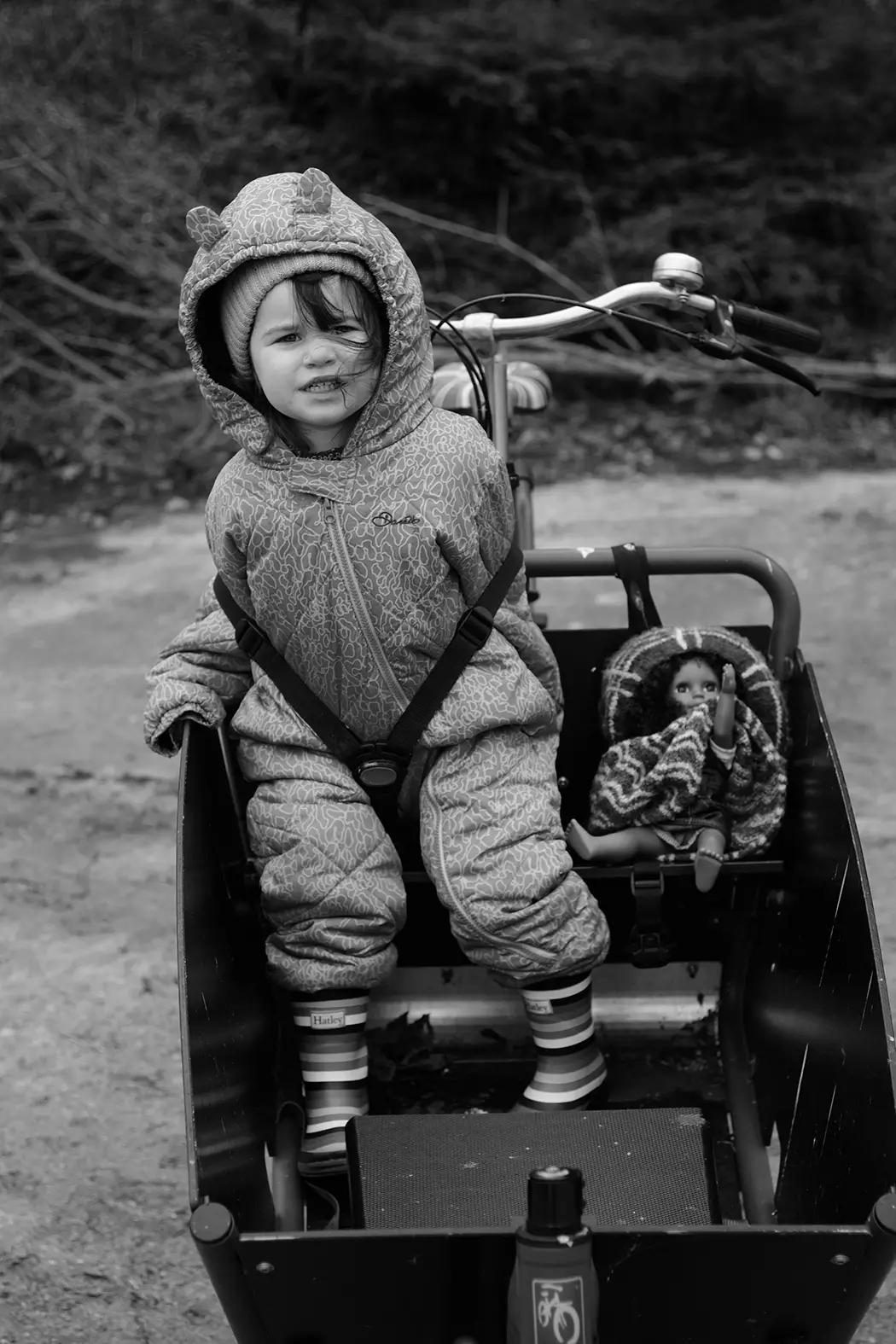
My daughter turned two and a half this month, and she is indeed a thoroughly photographed child. Just like any other new parents these days, my husband and I have amassed a hard drive’s worth of phone images documenting her many adventures. To a lesser extent, we also have some ‘real’ camera shots captured digitally and on film. The pictures are numerous, fun, and deeply special to our family. They are also photographically unremarkable. Few, if any, are Photographs of the type I had envisioned taking of my daughter – images which stand up on their own merit as photos and reflect the qualities I strive for in my work. It is as if as soon as I point a camera at my child, all my artistic vision, imagination and skill deteriorate.
I am not generally prone to feelings of guilt when it comes to motherhood. When unable to produce enough breastmilk, I supplemented with formula. I abandoned my intent to baby-cary when my back proved not up to the task. When my daughter was one and a half, I enrolled her in daycare in order to work longer hours. None of these actions made me feel like a bad mother. But, oddly, I feel as if I have failed by not managing to capture my child photographically in the manner I’d hoped to. I have taken striking and noteworthy portraits of other people – including strangers – since my daughter was born; so it isn’t as if I have lost my touch. Why, then, have I been so profoundly inept at photographing her?
At the start of this year I decided to explore this predicament. I set a task for myself to photograph my daughter in a way that would yield creatively satisfying results. I approached the situation with the same rational determination, as I would with a work-related project – first reviewing my images to identify what exactly was wrong.
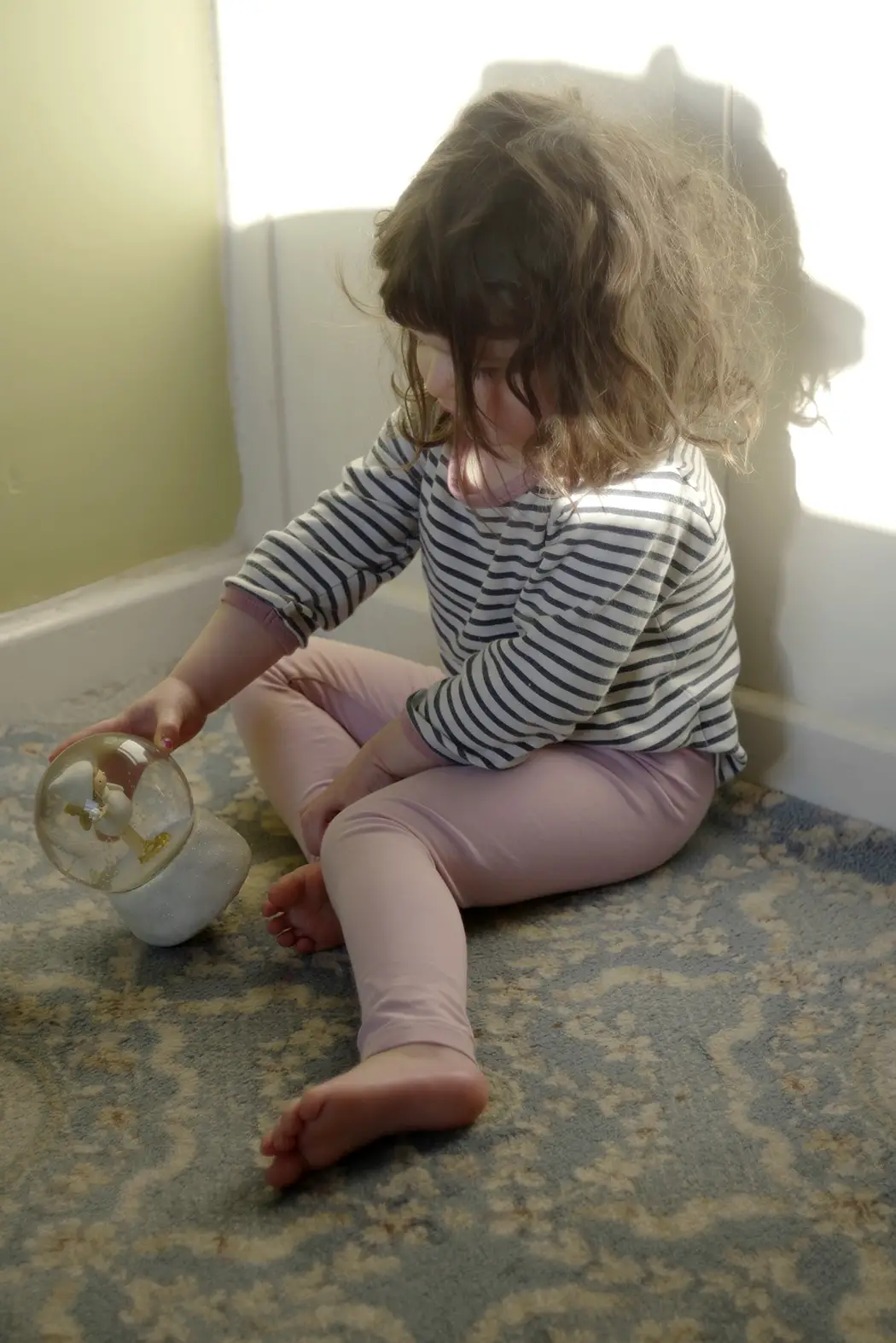
It was clear that some of the difficulties were technical. While using manual-focus equipment never posed a problem for me previously, with a creature who never kept still things became more challenging. My ratio of in-focus vs out-of-focus images was uncharacteristically low.
Lighting and composition were also problematic. Because my daughter refused to remain where I placed her, or to keep her face turned in the direction of the light, I found it next to impossible to light her in the manner I wanted or even to decently compose the shot. I could set the scene as picturesquely as I liked, but in the time it took me to adjust the focus and release the shutter, she would be in a different location and pose entirely. Chasing her around the house or garden with a camera whilst adjusting the settings back and forth manically has provided me with many a workout!
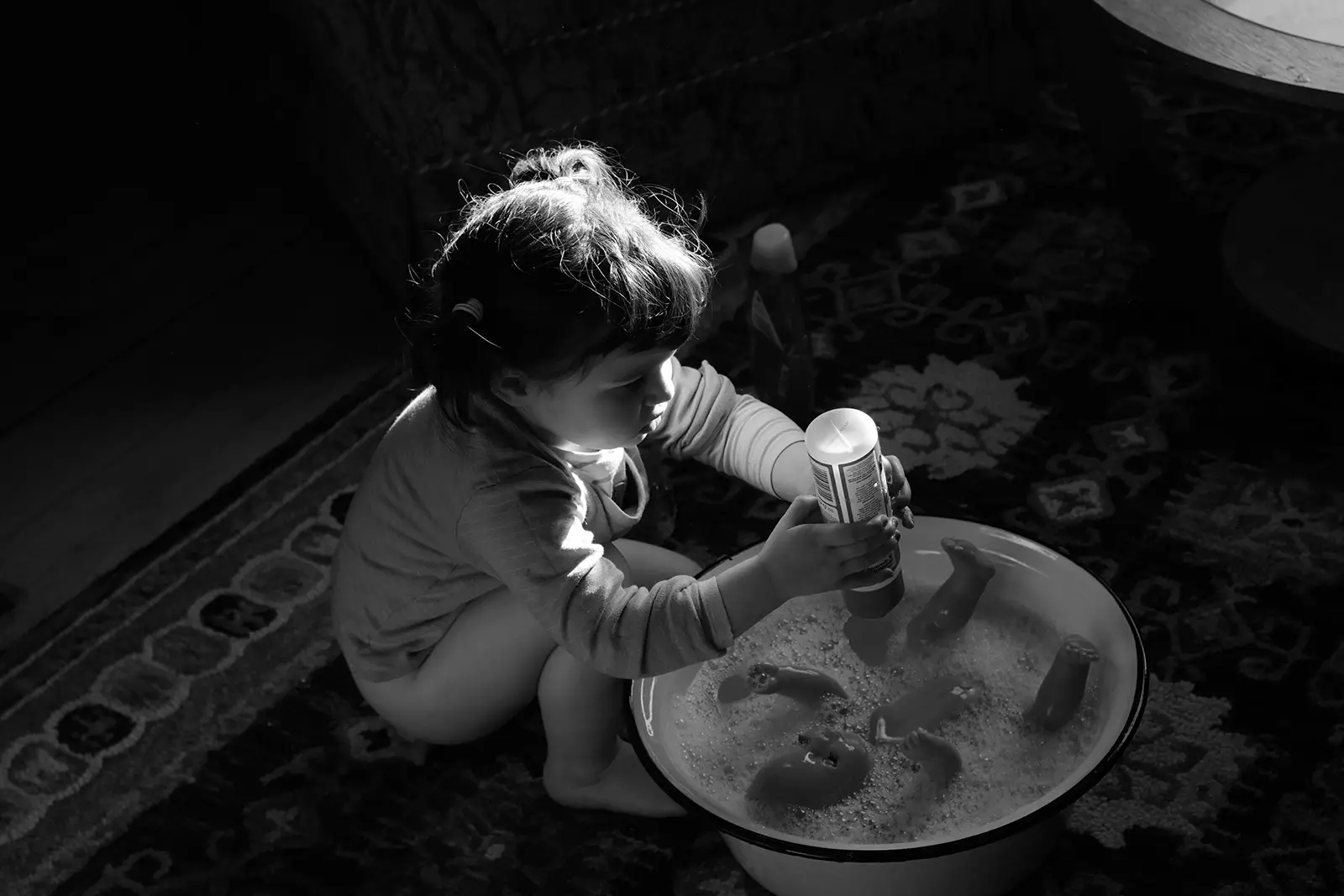
Although the world of babies and children was entirely foreign to me until I had my daughter, I did know well enough to understand she was not a doll and could not be expected to behave like one. So I don’t mean to imply that I expected her to pose for formal portraits or tableaux images! What I mean is, that even in natural uncontrived settings, she moved faster and more unpredictably than what my skills could handle. In the past, I have photographed both weddings and bicycle races using all-manual equipment with no issues. But capturing a my daughter proved more challenging!
There were two possible solutions to this, I figured: I could either cave in, use my camera’s auto-settings and buy an auto-focus lens. Or, I could make a concerted effort to practice and improve my reaction times and the speed of my visual decision-making. I decided to do the latter. Remarkably, after only a month of a self-imposed phone ban {meaning, I was only allowed to photograph my daughter with a ‘proper’ camera and not with my phone}, the technical issues improved.
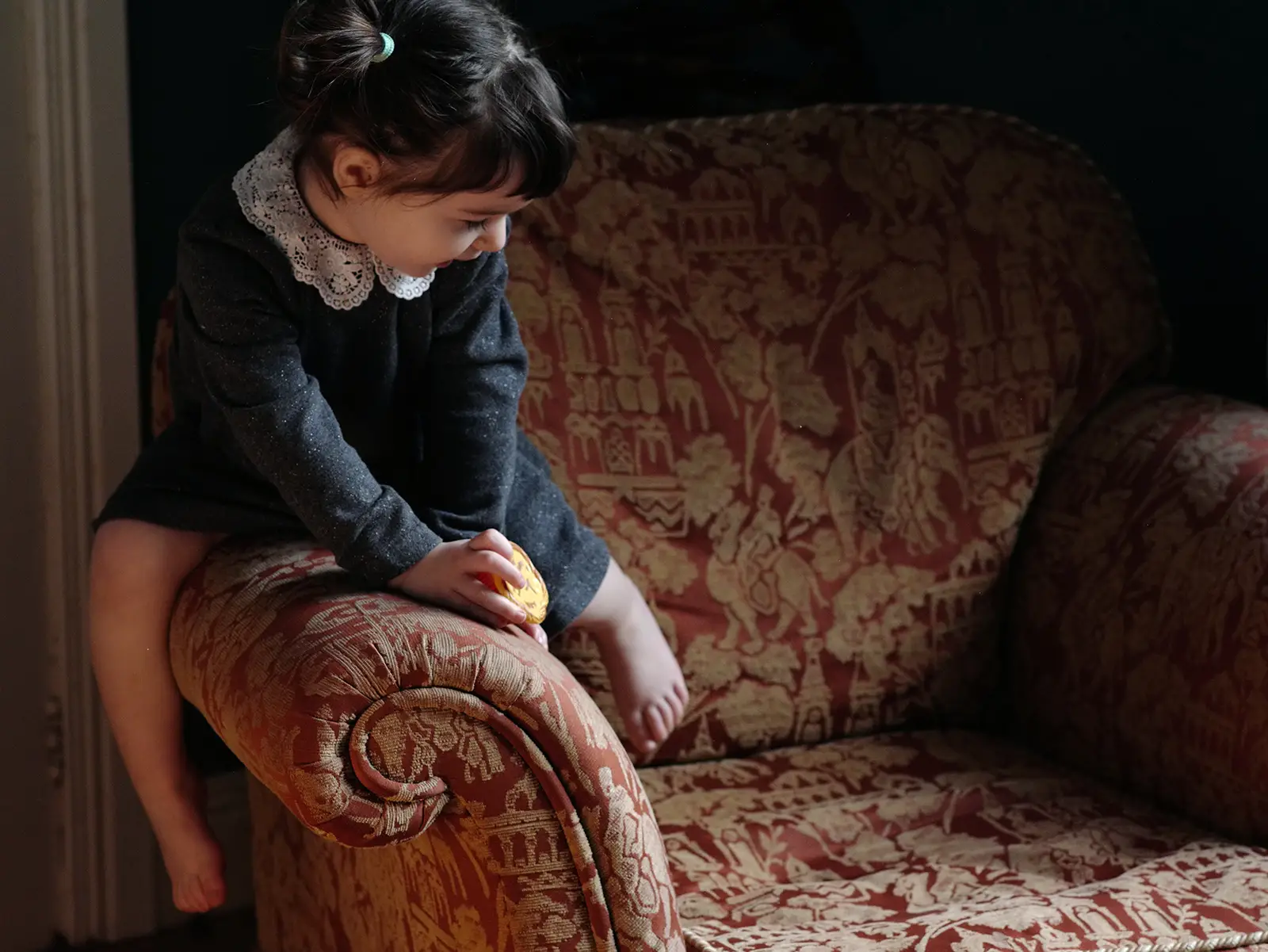
But ironically, improving my technique made me realise that the real problem was more fundamental. At its core, my approach to portraiture did not fit with my daughter’s personality and demeanour. There is a certain Expressive Stillness I strive for in the portraits I take, and it is the quest for this quality that drives my work. To achieve it, I need to establish a degree of non-verbal rapport with the subject, to frame the scene in a particular manner, and to control the setting. These elements characterise my photos regardless of whether they are posed studio portraits, or spontaneous shots taken in a natural setting. Even my candid street photos tend to look like tableaus, so tightly and carefully I manage them.
With her feral rambunctious ways, my daughter is simply not compatible with this style of capture. She does not ‘do’ stillness. Even as an infant, she was perpetually animated, mischievous, prone to comically expressive gestures and clownish facial expressions. She also makes a tornado of a mess with impressive swiftness wherever she goes, so ‘controlling the set’ is next to impossible. No sooner is a beautifully lit backdrop erected, then it is covered with bits of shredded napkin, and perhaps some regurgitated pancake. Items of clothing are removed. Monkeyish faces are pulled. And manic thrashing ensues, to accompany a badly corrupted rendition of the Baby Shark theme song.
I consulted with an acquaintance who specialises in child photography. She assured me that my frustrations were not unique. In fact, many of her clients are themselves photographers, who struggle with photographing their own children. She suggested some tips and tricks used to ‘wrangle’ young children, and I set out to implement her advice. I bribed my daughter with biscuits into sitting still and sweetly holding a toy train – when what she really wanted to do was run amok and rip up the packaging. I also tried the trick of setting her across from a screen playing cartoons at camera level, so that she would appear to be looking with interest at the camera when the photo was being taken.
Technically, these methods did work – in the sense that, for the duration of time it took her to munch the biscuit and/or get bored of Peppa Pig’s antics, she stayed still allowing me to photograph her in the manner I wanted and with the composition I had in mind. But the resulting photos looked ‘off’ and for all the effort that went into them, they did not feel artistically successful. There was a sad cynical falseness, I felt, in luring my child into a pose that wasn’t natural to her. It finally dawned on me, that all along I was trying to get my daughter to behave in accordance with what I wanted to photograph. Whereas perhaps what I should be doing, is accepting her own terms and changing my style to accommodate.
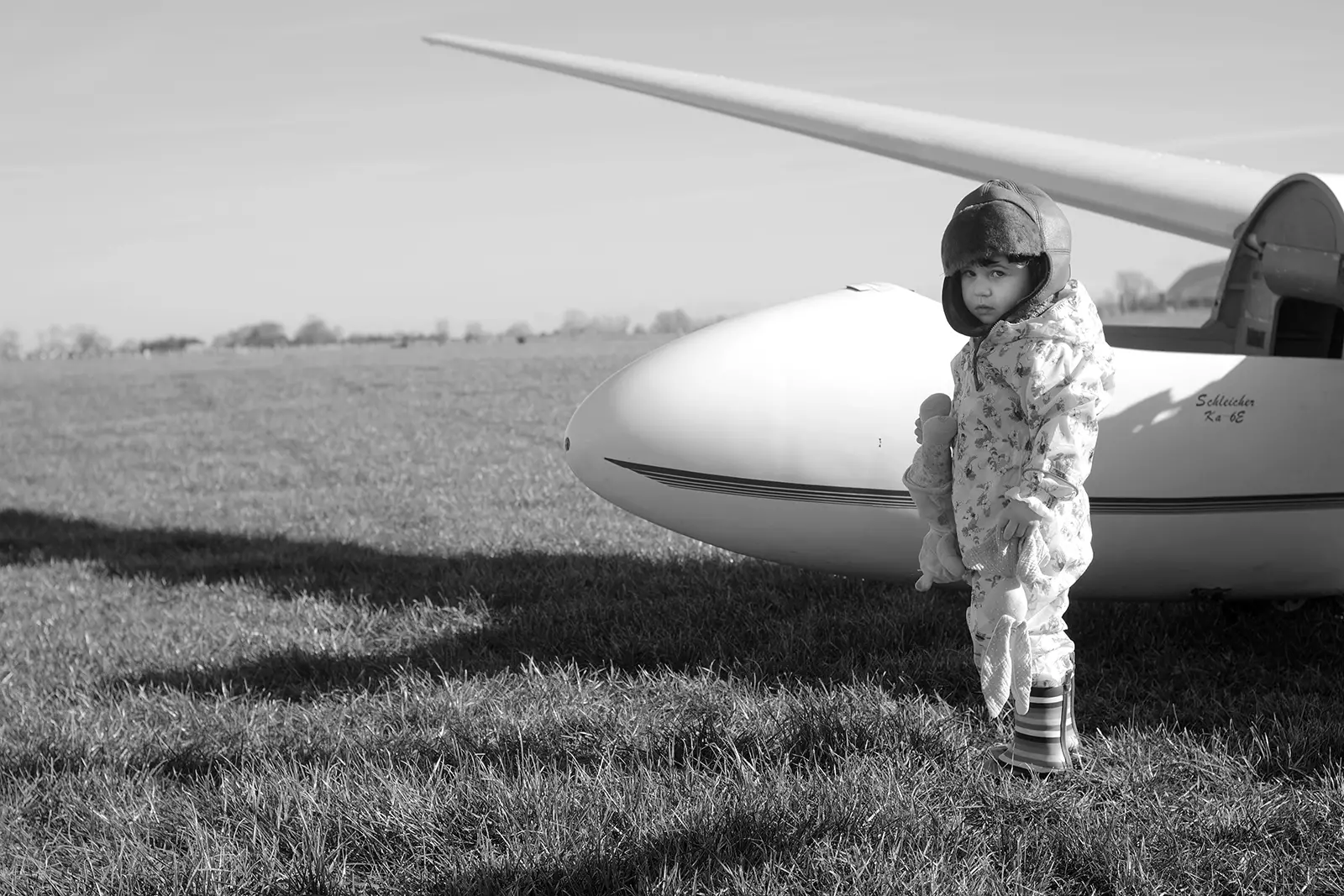
I began to notice another phenomenon at play in my efforts to photograph my daughter.
In the act of taking photos, I switch into a special mode of thinking, feeling, and relating to the person in front of the camera. And that mode feels incompatible with being a mother. So to treat my daughter as a photographic subject – to study and approach her in a manner guided by aesthetic considerations – feels almost painfully at odds with the very different, protective, visceral and hyper-empathetic, way I would normally relate to her.
I suppose that when I take a snapshot with my phone, it is such a casual, incidental act; I hardly even look at what I am snapping and that allows me to stay if not entirely engaged then at least more engaged. But a ‘real’ camera literally gets between us; it forms a physical barrier. I am not engaged with my daughter when I photograph her. I am engaged with the camera, and in that sense I separate myself from her in a way that feels physiologically wrong. I see her little face show signs of disappointment and loneliness when the camera appears; she wants to play with me, she wants my attention without an intermediary, she wants me to find her more captivating than a black {well, sometimes black and chrome} box. It is all very subtle, but it is there. And when I notice it, my heart breaks and I put the camera away. I am her mother, and no picture is worth this.
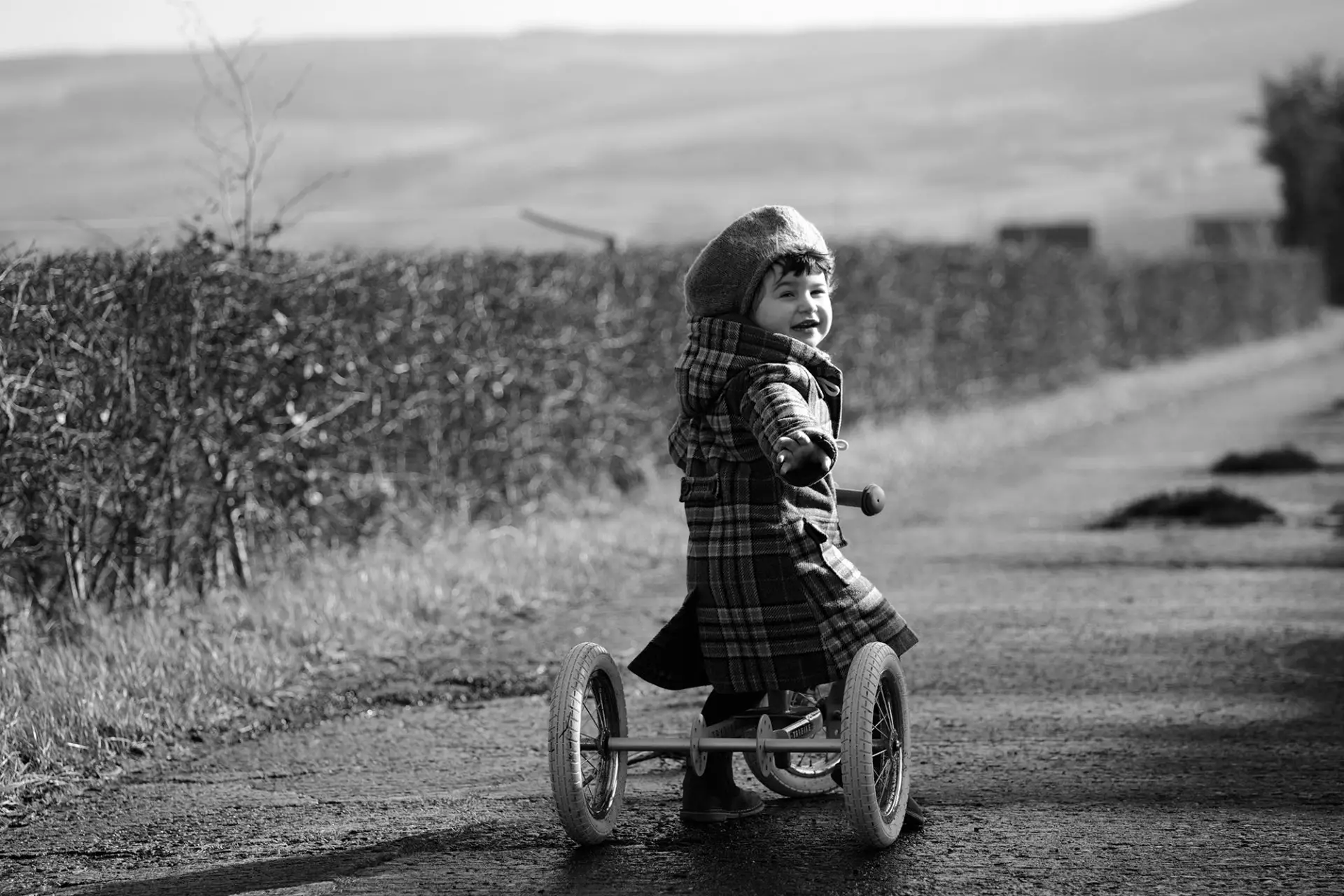
As part of this experience I have come face to face with some unexpected realisations – about my child, about our relationship, and about my relationship with photography.
In the past, I always thought the camera helped me relate to people. But now I have come to question this. Perhaps more likely, I use the camera so that I can appear to relate to people, while in fact not only keeping my distance, but creating an effective barrier between myself and others. In not allowing me to treat her this way and imploring me to be her mother instead, my daughter has made me aware of this fact.
Can I be both a mother, and a photographer, to the full extent of what each of those concepts entail? I do not have the answer. But I am working on evolving my method – toward something that works for both of us, not just for me. I am also working on myself, to redefine what I consider a successful portrait of my daughter. This involves relinquishing my preconceived notions of what photographing childhood entails, and welcoming the development of our own unique visual language.
___
NOTES
All images shown here taken with a digital Leica CL and the following lenses –
header image: Nikkor 50mm f1.2
second and 5th image: Leica Summicron-C 40mm f2
3rd, 4th & 6th image: Leica Summarit 75mm f2.4
Two noteworthy compilations, for anyone interested in photographers whose subjectmatter is their own children:
In Their Mothers’ Eyes: Women Photographers and Their Children, by Martina Mettner
Photographing Childhood: The Image and the Memory, by LaNola Stone
Ailbíona McLochlainn is a photographer, knitwear designer, and recovering academic, based in Ireland. For additional information and lots of pictures to look at, visit www.ailbiona.com
Share this post:
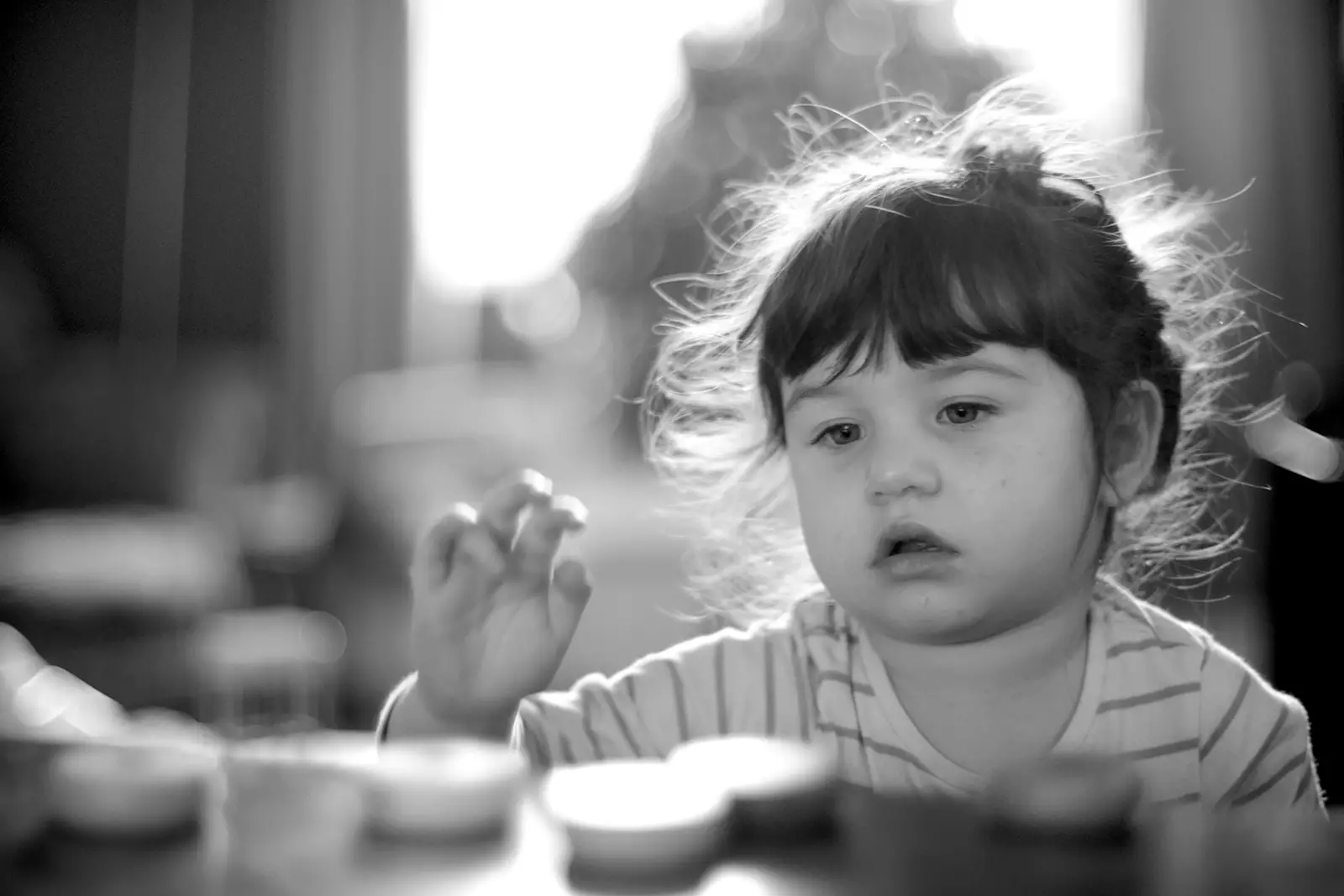








Comments
shannon on The Mother and The Photographer – By Ailbíona McLochlainn
Comment posted: 30/03/2022
Comment posted: 30/03/2022
Bill Brown on The Mother and The Photographer – By Ailbíona McLochlainn
Comment posted: 30/03/2022
My mom lived far away and didn't get to see her grand baby as often as she would have liked so I joked that she could just flip through the photo prints of her and see her grow. I made my daughter an identical camera as the Canon z-115 out of a Raisin Bran cereal box and it even had a working view finder. That camera is now in her keepsake box. I worked at making the camera part of our everyday play. One time we spent several hours posing all of her playhouse people and pets into family portraits. I used my Canon f1-n for that. I also tried to photograph her environment without her present. These images are special to me because they show distinct short lived moments in her life. All of her stuffed animals on the shelf, the playhouse figures placed around the sides of the bathtub, etc.
As she grew up I became the event photographer for all the school activities. Medieval Feast in fourth grade, the overnight sixth grade field trip, college day in eighth grade, her first prom in tenth grade and then graduation day (and many others). I was usually the only dad on field trips so hanging and talking with the other moms just seemed normal. The teachers and parents just thought of me as the crazy dad who likes to take pictures and with a film camera! The one repeated event was for me to photograph her on the first and last day of school. I started when she was in Pre-K (age 3) and finished with her standing alone with her car in the school parking lot. Covid-19 meant her last weeks of high school were online.
For her senior year her I hung a new photo on her bedroom door every week. The first photo was the day she was born and the last photo was from her graduation day. She now has a wonderful folio of prints of her young life. It all seemed to pass about as quickly as you've read this response. Don't take it too serious, just enjoy each passing moment and let photography be as fun as playing with your daughter. Our daughter is finishing her second year at University and isn't around for me to photograph any more. Boy, I sure do miss the playdoh, the crayons, the paints, the dolls and the dress up.
The Dad and the photographer.
Comment posted: 30/03/2022
Philip Ahlquist on The Mother and The Photographer – By Ailbíona McLochlainn
Comment posted: 30/03/2022
I wonder if we all bring our own preferences and preconceptions to the task. When I get the chance, my subject of choice for photographs is seabirds, ideally in flight. So I’m used to wildly unpredictable and erratic subjects, and my digital photography set up is designed for it. Very good for children. But also - just like with birds - it can be really difficult to do any deliberate composition. That’s where my method needs to evolve. Thanks again for sharing. I think I’ll need to read this a few times more!
Comment posted: 30/03/2022
Brian Nicholls on The Mother and The Photographer – By Ailbíona McLochlainn
Comment posted: 31/03/2022
Comment posted: 31/03/2022
doc Deutschmann on The Mother and The Photographer – By Ailbíona McLochlainn
Comment posted: 31/03/2022
Funnily I have heard both: Looking through the camera for a portrait means "connecting" to the people in front of the lens, as well as "putting a distance in between the photographer and the photographed".
I've heard of conflict photographers, who said "I could not possibly bear the pain of the people in my images, if it weren't for the camera..." at the same time, they do connect in order to make the pain relatable to the viewer.
Similar is true for fashion photographers - they're not interested in the "person" in front of the lens, but in the looks -but they still need to "connect" to their models in order to get the shots they want.
Maybe photographing our own children is different. With them it is way more difficult to do both - "connect" to them as we know them, as we see them with our hearts (not our cameras) and at the same time "put the distance" between them and us, to fulfill our expectations about the "artfulness" of our product.
I actually doubt that it makes a difference for the "image" as a product. You may be disappointed (or at least not fully satisfied) with the outcome, but in 20 (or 30) years, the aesthetic of the image has taken a back seat, and the content is going to be WAY MORE important than any self-inflicted expectations of aesthetics.
The images will be priceless (their "looks" will hardly matter).
Comment posted: 31/03/2022
Cody on The Mother and The Photographer – By Ailbíona McLochlainn
Comment posted: 31/03/2022
A profound and relatable article for me as a dad photographer taking images of my first born (almost two now). I have an abundance of blurry/out of focus film shots and even more digital shots (not counting those phone snaps as well) I have a particularly difficult time with my TLR as I look through the magnifier, flip it down, and then compose from there...my son thinks he's funny and lurches in and out of the focal plane I've selected and I let out a sigh and put the camera back on the shelf. Digital and autofocus is definitely preferred in most scenarios...
The quote above struck me hard and it's one I haven't taken the time to think about. As parents we are so afraid of letting moments slip by that we try to capture them photographically and are left in a constant duality of living in the moment and prioritizing capturing something tangible to remember it. I think it's at this point we separate the art from the photo because it's the subject that is so much more valuable than the composition. Sally Mann found a way to infuse both, but at what cost.
Comment posted: 31/03/2022
Matthias on The Mother and The Photographer – By Ailbíona McLochlainn
Comment posted: 31/03/2022
I have three children (now 12, 9 and 2 years old) and I have taken a lot of images of them.
And although I used for a great part of these image modern modern autofocus gear (and almost no mobil phones for my older childeren) there are very very few images that are more than just snaps. Surprisingly some the better ones came from my manual focus Minolta or Yashica SLRs.
I also know the topic very well, that a camera get's between me and my family. I never feel like this, but my wife does many times, arguing that I'm not really present at familiy trips. This may be true.
My older children now are in an age where I have to ask their permission to photograph them, which I rarely get. So game over for better images of them. But there is still my little daughter. She'll be the child with the best photos I hope.
Regards and all the best for your family
Matthias
Comment posted: 31/03/2022
Mike on The Mother and The Photographer – By Ailbíona McLochlainn
Comment posted: 01/04/2022
Thank you.
Comment posted: 01/04/2022
Johan on The Mother and The Photographer – By Ailbíona McLochlainn
Comment posted: 03/04/2022
Comment posted: 03/04/2022
Tim Bradshaw on The Mother and The Photographer – By Ailbíona McLochlainn
Comment posted: 04/04/2022
Except, of course, you do have an answer, just in in photographs not in words.
Peter on The Mother and The Photographer – By Ailbíona McLochlainn
Comment posted: 06/04/2022
Comment posted: 06/04/2022